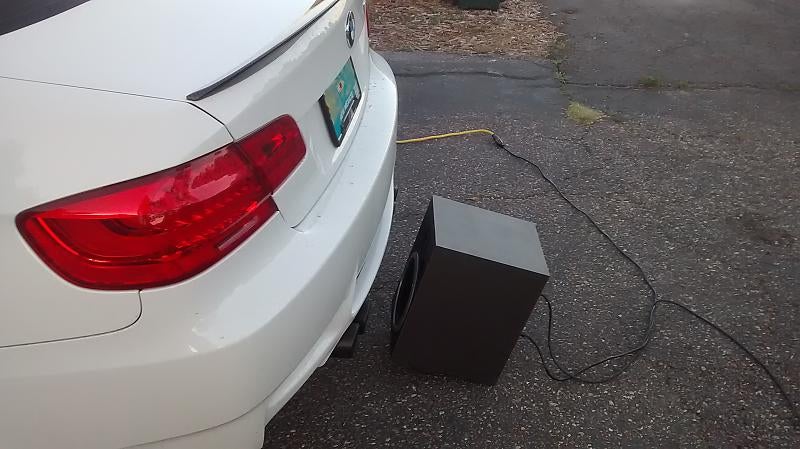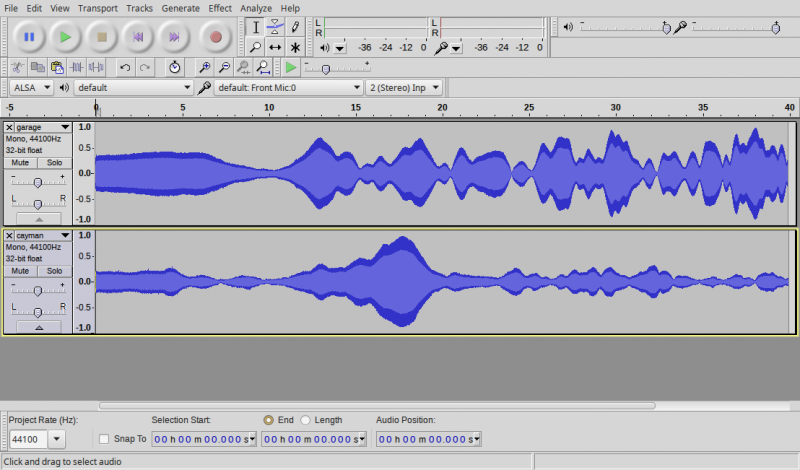Carrying on part of the conversation from Plainsman's informative thread on fixing drone with a Borla here: http://www.planet-9.com/987-cayman-...ayman-and-boxster-modifications/139529-simple-basic-cat-back-exhaust-build.html
So I suspected that a large factor in drone of exhausts on Caymans (and M3s) is not directly attributable to the geometry of the exhaust because as Plainsman has shown with his exhaust mods, it can be very difficult to make changes to the exhaust that effectively reduce drone. If the cabin has a resonance (an eigenmode) centered around a particular frequency that is excited by the exhaust noise coming from the tailpipe, then a small increase in exhaust noise could lead to a large amplitude "drone" in the cabin. The exhaust does not have to resonate at the same frequency... it just has to be loud enough to excite the mode. Since the Borla is loud at pretty much every frequency, we end up with drone. Or at least that's my working hypothesis.
The procedure: to test this, I setup a studio monitor behind the car, tilted up towards the tailpipe, and drove it with a frequency sweep from 50 Hz to 400 Hz, logarithmic in time over 40 sec. I recorded the sound with an Audio-technica ATR6250 shotgun microphone both inside and outside of the car (to get a control point because the system has nowhere near a flat frequency response, even outside of the car). I then normalized and filtered the results in Audacity. I did this with my Cayman and my E92 M3.
Ghetto frequency response setup for the M3 (forgot to snap one of the Cayman):

Results for Cayman: The image below shows two amplitude traces of the frequency sweep for the Cayman while it was parked inside the garage with the tailpipe pointed out of the garage door opening. The top trace is with the microphone outside the car; bottom is the microphone inside the car held up by my right ear while sitting in the driver's seat:

Obviously, the garage itself (3-car, 24ish ft deep) is having a large effect even though the monitor is actually just outside the door. So that was a mistake, and I need to re-do this part outside of the garage. But still... check out that huge lobe centered around 17 seconds! That corresponds to 110-130 Hz. In rpm, that range corresponds to 2200 to 2600 rpm. I don't currently have the Borla, so I can't remember exactly where the drone was, but it was somewhere around there.
Results for M3:I did the same thing on the M3, but this time I measured both the control and the car with the car parked outside of the garage:

The trace is noisier due to some wind, but the overall control pattern is smoother when the studio monitor is not inside the garage. On this car, there are resonances down around 75 Hz and up at 200 Hz (at 15.5 s and 27 s, remember it's a log sweep, not linear). The 200 Hz resonance corresponds to drone around 3000 rpm, which is definitely something I hear (this car does have a Borla). I don't ever hear the 75 Hz resonance which would be at 1125 rpm.
Here's one more image. This is the raw result of the Cayman (top) vs the raw result of the M3 (bottom). These traces have not been normalized or filtered, so you can see a lot of other stuff going on. This illustrates the relative differences of interior noise of the two cars with the amplification at the same setting. The M3 is a much quieter car (bigger, heavier, and easier to add more sound insulation), especially at these lower frequencies where drone and tire noise occur.

So I suspected that a large factor in drone of exhausts on Caymans (and M3s) is not directly attributable to the geometry of the exhaust because as Plainsman has shown with his exhaust mods, it can be very difficult to make changes to the exhaust that effectively reduce drone. If the cabin has a resonance (an eigenmode) centered around a particular frequency that is excited by the exhaust noise coming from the tailpipe, then a small increase in exhaust noise could lead to a large amplitude "drone" in the cabin. The exhaust does not have to resonate at the same frequency... it just has to be loud enough to excite the mode. Since the Borla is loud at pretty much every frequency, we end up with drone. Or at least that's my working hypothesis.
The procedure: to test this, I setup a studio monitor behind the car, tilted up towards the tailpipe, and drove it with a frequency sweep from 50 Hz to 400 Hz, logarithmic in time over 40 sec. I recorded the sound with an Audio-technica ATR6250 shotgun microphone both inside and outside of the car (to get a control point because the system has nowhere near a flat frequency response, even outside of the car). I then normalized and filtered the results in Audacity. I did this with my Cayman and my E92 M3.
Ghetto frequency response setup for the M3 (forgot to snap one of the Cayman):

Results for Cayman: The image below shows two amplitude traces of the frequency sweep for the Cayman while it was parked inside the garage with the tailpipe pointed out of the garage door opening. The top trace is with the microphone outside the car; bottom is the microphone inside the car held up by my right ear while sitting in the driver's seat:

Obviously, the garage itself (3-car, 24ish ft deep) is having a large effect even though the monitor is actually just outside the door. So that was a mistake, and I need to re-do this part outside of the garage. But still... check out that huge lobe centered around 17 seconds! That corresponds to 110-130 Hz. In rpm, that range corresponds to 2200 to 2600 rpm. I don't currently have the Borla, so I can't remember exactly where the drone was, but it was somewhere around there.
Results for M3:I did the same thing on the M3, but this time I measured both the control and the car with the car parked outside of the garage:

The trace is noisier due to some wind, but the overall control pattern is smoother when the studio monitor is not inside the garage. On this car, there are resonances down around 75 Hz and up at 200 Hz (at 15.5 s and 27 s, remember it's a log sweep, not linear). The 200 Hz resonance corresponds to drone around 3000 rpm, which is definitely something I hear (this car does have a Borla). I don't ever hear the 75 Hz resonance which would be at 1125 rpm.
Here's one more image. This is the raw result of the Cayman (top) vs the raw result of the M3 (bottom). These traces have not been normalized or filtered, so you can see a lot of other stuff going on. This illustrates the relative differences of interior noise of the two cars with the amplification at the same setting. The M3 is a much quieter car (bigger, heavier, and easier to add more sound insulation), especially at these lower frequencies where drone and tire noise occur.





